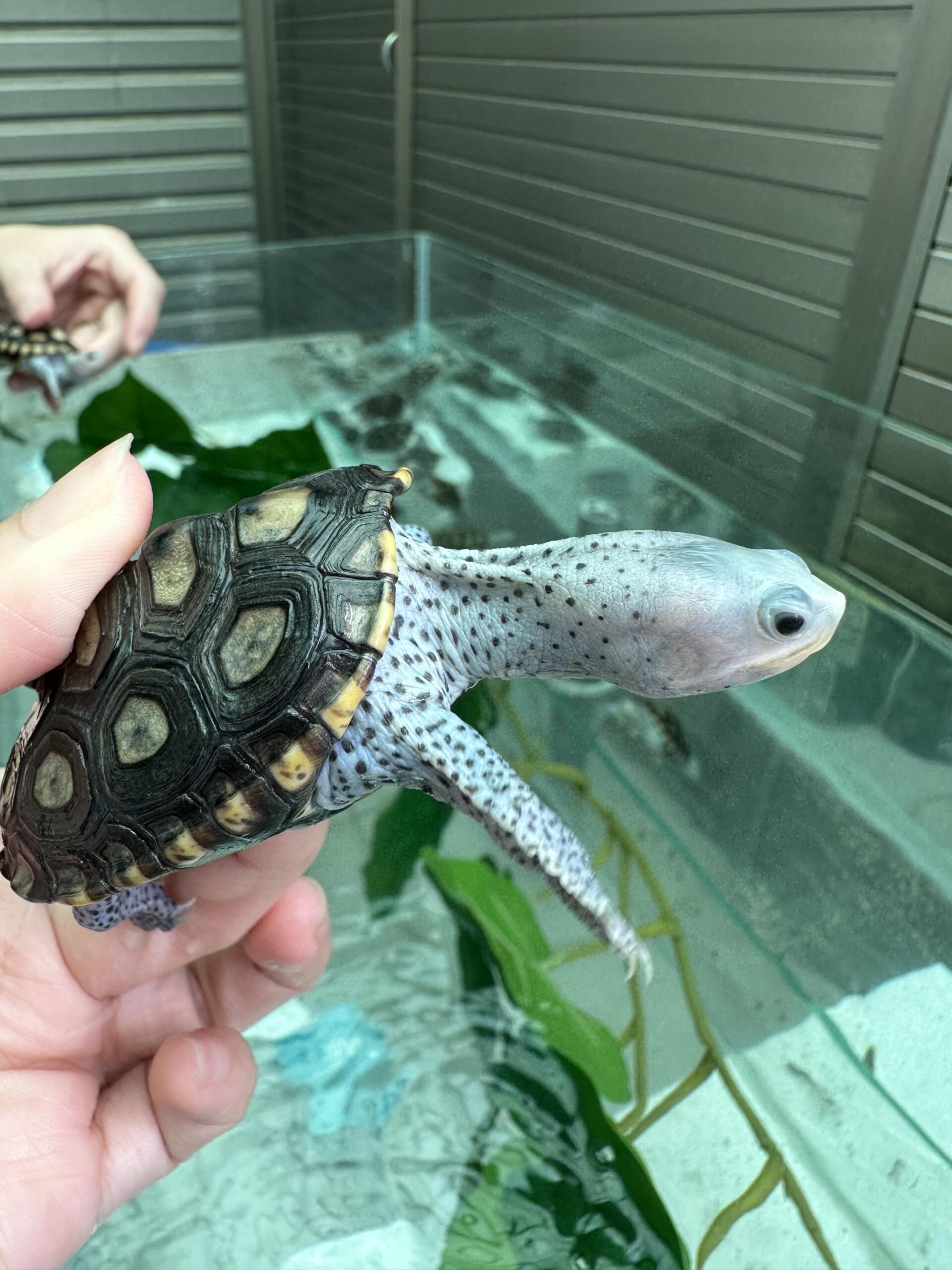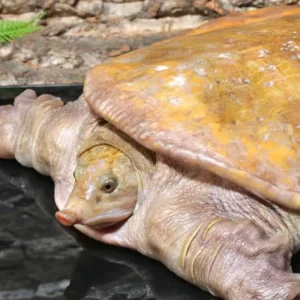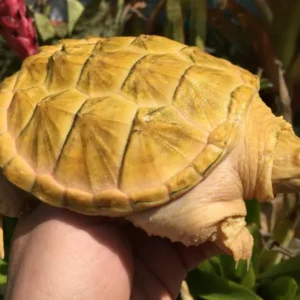Diamondback Terrapin For Sale
$520.00
Ornate Diamondback Terrapins
- We have beautiful Ornate Diamondback Terrapins for sale
- Males and Females
- Size: These are 2022 hatchlings. Roughly four inches in size.
- Typical Habitat: Fully aquatic
- Description:These are Captive born baby ornate diamondback terrapins. This all have perfect scutes and perfect tails. These are kept in freshwater.
- Food:Blood worms and turtle pellets
- Please know your state laws!!!
- Free shipping
Furthermore,
The Diamondback Terrapin for sale (Malaclemys terrapin) is a species of turtle native to the coastal marshes and estuaries of the eastern and southern United States. They are known for their distinctive diamond-shaped patterns on their carapace (upper shell), which vary in color and can include shades of black, gray, or brown.
Here are some key features and characteristics of the Diamondback Terrapin for sale:
- Habitat: Diamondback Terrapin for sale are primarily found in brackish coastal waters, including tidal marshes, estuaries, and lagoons. They have a unique ability to tolerate varying levels of salinity in the water.
- Appearance: These turtles have a relatively flattened shell and webbed feet, adapted for their semi-aquatic lifestyle. The carapace often exhibits a pattern of concentric rings or diamond-shaped markings. The coloration of the carapace can vary widely among individuals and is influenced by factors such as age, sex, and geographic location.
- Behavior: Diamondback Terrapins are known for their strong territorial instincts. They are capable swimmers but are also adapted to spend time on mudflats and in marshy areas. They are opportunistic feeders, consuming a variety of prey, including crustaceans, mollusks, fish, and aquatic vegetation.
- Reproduction: Female Diamondback Terrapin for sale typically nest in sandy areas during the nesting season. After laying eggs, they cover the nest with sand. The temperature during incubation can influence the sex of the hatchlings.
- Conservation Status: Some populations of Diamondback Terrapins face threats from habitat loss, road mortality, and collection for the pet trade. As a result, they are considered a species of conservation concern in some regions, and efforts are made to protect their habitats and manage potential threats.
It’s important to note that the conservation status and specific threats to Diamondback Terrapin populations can vary across their range, and conservation measures may be in place to ensure their survival.
Description
Diamondback Terrapin
The diamondback terrapin, scientifically known as Malaclemys terrapin, is a captivating species that inhabits the brackish coastal waters of the eastern and southern United States. Renowned for its distinctive diamond-shaped patterns on its carapace, the diamondback terrapin stands out not only for its unique appearance but also for its ecological and cultural significance.
This medium-sized turtle exhibits a shell that is both intricate and visually striking, with raised, concentric rings that form diamond-like shapes, hence the name. The coloration of the shell can vary from grayish to brown, often accentuated with lighter or darker spots and markings. Their limbs are typically adapted for a life spent in brackish environments, featuring webbed feet that aid in swimming through the mix of salt and fresh water found in their habitats.
The diamondback terrapin’s habitat is largely confined to the salt marshes, estuaries, and tidal creeks along the Atlantic and Gulf coasts. These environments provide a delicate balance of salinity that the terrapins have uniquely adapted to, allowing them to thrive where few other reptiles can. Their diet mainly consists of mollusks, crustaceans, and small fish, contributing significantly to the health of their ecosystems by controlling the population of these species.
Ecologically, the diamondback terrapin plays a crucial role in maintaining the balance of coastal ecosystems. By preying on periwinkle snails, for instance, they help control the snail population, which in turn protects the marsh grasses that are vital for preventing coastal erosion. Culturally, the diamondback terrapin has held a place of importance, especially in regions like Maryland, where it has been designated as the official state reptile and is a symbol of local heritage.
Understanding the diamondback terrapin is essential for conservation efforts, as their habitats are increasingly threatened by human activities such as coastal development and pollution. Protecting this unique species ensures the preservation of the intricate web of life that depends on the delicate balance of brackish water ecosystems.
The diamondback terrapin (Malaclemys terrapin) is predominantly found along the eastern and southern coasts of the United States. This species inhabits a range of coastal ecosystems, stretching from Cape Cod in Massachusetts to the Gulf Coast of Texas. Within this extensive geographic range, diamondback terrapins thrive in various brackish water environments, including salt marshes, estuaries, and tidal creeks.
Salt marshes, characterized by their saline soil and halophytic vegetation, provide ideal conditions for the diamondback terrapin. These marshes are often located in estuarine environments where freshwater from rivers meets and mixes with the saline waters of the ocean. The brackish water in these habitats offers a balanced salinity level that is essential for the terrapin’s survival. Estuaries and tidal creeks, with their fluctuating salinity levels and nutrient-rich waters, also support robust terrapin populations.
The distribution and abundance of diamondback terrapins are significantly influenced by tidal patterns. These turtles rely on the tidal cycles to access feeding grounds and nesting sites. During high tide, terrapins move into the marshes and estuaries to forage for food, which includes mollusks, crustaceans, and small fish. Conversely, low tide exposes mudflats and sandbars, providing critical basking and nesting areas. The interplay of tidal rhythms ensures that terrapins have access to diverse habitats necessary for their life cycle.
Salinity levels within their habitats are another crucial factor determining the distribution of diamondback terrapins. These reptiles exhibit a remarkable tolerance for varying salinity, which allows them to inhabit regions with fluctuating salinity levels. However, extreme salinity changes, often caused by human activities such as coastal development and pollution, can disrupt their habitat and pose significant challenges to their survival.
Understanding the natural habitat and distribution of the diamondback terrapin is vital for conservation efforts. Protecting these unique coastal environments not only supports the terrapins but also preserves the ecological integrity of the regions they inhabit.
Physical Characteristics and Adaptations
The diamondback terrapin is a remarkable species of turtle known for its distinctive physical traits and adaptations, which enable it to thrive in its natural habitats. One of the most notable features of the diamondback terrapin is its unique shell pattern. The carapace, or upper shell, is usually characterized by intricate, concentric diamond-shaped markings, which give the species its name. These patterns are not only aesthetically striking but also provide a degree of camouflage against predators in their marshy environments.
The terrapin’s webbed feet are another crucial adaptation. These specialized limbs facilitate efficient swimming, allowing the terrapin to navigate both fresh and brackish waters with ease. This adaptability is essential for their survival, as they often inhabit tidal creeks, estuaries, and coastal salt marshes. The webbing between their toes provides the necessary propulsion for swimming, while their sturdy claws enable them to climb onto muddy banks and navigate terrestrial terrains.
In addition to their shell and feet, diamondback terrapins possess strong, powerful jaws. These jaws are well-adapted for their diet, which primarily consists of mollusks, crustaceans, and various small aquatic organisms. The terrapin’s jaws can exert significant force, allowing them to break through the hard shells of their prey, making them efficient hunters within their ecosystem.
Sexual dimorphism is another interesting aspect of the diamondback terrapin’s biology. Females are generally larger than males, a trait that has significant implications for their behavior and life cycle. This size disparity is particularly noticeable during the breeding season, as larger females are more capable of producing and carrying a greater number of eggs. Consequently, this increases their reproductive success and ensures the continuation of their lineage.
The larger size of females also impacts their behavior. Bigger females tend to be more dominant and may occupy more favorable nesting sites, which can affect the distribution of the population within a given habitat. Males, being smaller, are more agile and better suited for navigating through dense vegetation and escaping from potential threats.
Diet and Feeding Habits
The diamondback terrapin, an intriguing species of turtle inhabiting brackish coastal waters, boasts a diverse diet primarily composed of aquatic organisms. Among their favored food sources are mollusks, crustaceans, and small fish. These terrapins exhibit specialized feeding behaviors that enable them to thrive in their unique habitats. Their robust jaws play a crucial role in their ability to consume hard-shelled prey, such as clams and crabs, by crushing these tough exteriors to access the nutritious inner tissues.
Diamondback terrapins are opportunistic feeders, adapting their diet based on the availability of food sources within their environment. During warmer months, when aquatic life is more abundant, terrapins often consume larger quantities of crustaceans, like fiddler crabs and blue crabs, as well as a variety of mollusks, including snails and mussels. Small fish also constitute a significant part of their diet during these periods of plenty.
Seasonal variations significantly influence the feeding habits of the diamondback terrapin. In colder months, when certain prey species become scarce, terrapins may switch to alternative food sources. They may forage for detritus, algae, and other plant material, although animal prey remains their primary dietary component. This adaptability ensures their survival across different seasons and varying environmental conditions.
Foraging for food often involves a combination of active hunting and scavenging. Diamondback terrapins are known to use their keen sense of smell and vision to locate prey. They may dig into the sediment to uncover hidden mollusks or employ ambush tactics to catch unsuspecting fish. This versatile approach to feeding underscores their resilience and adaptability as a species.
Overall, the diet and feeding habits of the diamondback terrapin illustrate a remarkable ability to exploit a wide range of food sources within their habitat. Their powerful jaws and adaptive foraging strategies enable them to thrive in diverse and changing environments, making them a fascinating subject for further study and conservation efforts.
Life Cycle and Reproduction
The diamondback terrapin exhibits fascinating reproductive behaviors that are crucial for the survival of the species. Mating typically occurs in the spring, when males and females come together in shallow waters. Male terrapins engage in courtship rituals, which may include head bobbing and other displays to attract a mate. Once mating has occurred, females embark on the critical task of nesting.
Nesting usually takes place from late spring to early summer. Female diamondback terrapins seek out sandy or muddy shores, often traveling considerable distances to find a suitable site. They dig nests with their hind legs, creating a cavity where they lay their eggs. A single clutch can contain anywhere from 4 to 18 eggs, which are then covered with sand or mud to protect them from predators and environmental factors.
The conditions necessary for successful egg laying are quite specific. The nesting site must have the right temperature and moisture levels to ensure the eggs can develop properly. Incubation periods typically range from 60 to 120 days, depending on the ambient temperature. Warmer temperatures tend to hasten development, while cooler temperatures can extend the incubation period.
Once the eggs have incubated, hatching begins. Hatchlings use a specialized egg tooth to break through the shell. This process can take several hours to a few days. Upon emerging, the young terrapins face numerous challenges. Predation is a significant threat; various animals, including birds, raccoons, and crabs, prey on the vulnerable hatchlings. Environmental factors such as temperature and habitat quality also play a crucial role in their survival.
The early life stages of diamondback terrapins are fraught with peril. Hatchlings must quickly make their way to the water, where they continue to grow and develop. Despite the numerous challenges, these resilient creatures have adapted to their environments in remarkable ways, ensuring the continuation of this unique species.
Conservation Status and Threats
The diamondback terrapin, a unique and charismatic species native to the brackish coastal waters of the eastern and southern United States, is currently facing significant conservation challenges. Classified as “Near Threatened” by the International Union for Conservation of Nature (IUCN), the diamondback terrapin’s population is in a precarious state, with several factors contributing to its decline.
Habitat destruction is one of the primary threats to the diamondback terrapin. Coastal development and the degradation of salt marshes and estuaries have significantly reduced the natural habitats available for these turtles. This loss of habitat not only limits their living space but also affects their nesting sites, crucial for the reproduction of the species.
Climate change further exacerbates the problem. Rising sea levels and increased frequency of severe weather events threaten to inundate nesting sites and disrupt the delicate balance of coastal ecosystems. These changes can lead to a reduction in suitable habitats and affect the availability of prey, making it more difficult for diamondback terrapins to survive and reproduce.
Bycatch in crab traps is another significant threat. Diamondback terrapins often become unintended victims when they enter crab traps in search of food. Once trapped, they can drown if they are unable to reach the surface to breathe. This incidental capture has led to substantial mortality rates in certain areas, significantly impacting local populations.
Illegal poaching also poses a serious risk to the diamondback terrapin. The demand for terrapins in the pet trade and for their meat has driven illegal collection, further depleting their numbers. Despite regulations and protective measures, enforcement can be challenging, and poaching continues to be a problem.
To combat these threats, various conservation efforts have been implemented. Protective measures include the establishment of protected areas, regulations on crab trap designs to prevent bycatch, and initiatives to restore and preserve critical habitats. Public education campaigns and increased enforcement of wildlife protection laws are also vital components of the conservation strategy. These efforts aim to ensure the survival of the diamondback terrapin, preserving this remarkable species for future generations.
The Role of Diamondback Terrapins in Ecosystems
The diamondback terrapin holds a crucial position within coastal ecosystems, serving as both predator and prey, thereby maintaining ecological balance. As predators, these terrapins primarily feed on a variety of invertebrates, including snails, crabs, and small fish. This predation helps control the population of these species, preventing any single group from overwhelming the ecosystem. For instance, by consuming periwinkle snails, diamondback terrapins indirectly protect marsh grasses, which these snails would otherwise overgraze. This relationship showcases the terrapin’s role in maintaining the vitality of marshland habitats.
Furthermore, as prey, diamondback terrapins provide a vital food source for a range of larger predators, such as raccoons, foxes, and certain bird species. This dynamic illustrates the terrapin’s embeddedness within the food web, contributing to the dietary needs of these predators and supporting their populations. A decline in terrapin numbers could lead to a ripple effect, potentially destabilizing these predator populations and the broader ecosystem.
In addition to these direct interactions, diamondback terrapins also contribute to the health of coastal ecosystems through their nesting behaviors. By digging nests on sandy shores, they aerate the soil, which can enhance plant growth and reduce the prevalence of invasive plant species. This activity supports a diverse and healthy plant community, which in turn provides habitat and food for other wildlife.
Overall, the ecological importance of diamondback terrapins extends beyond their immediate interactions. They play a pivotal role in maintaining the balance and health of coastal ecosystems, highlighting the intricate interconnectedness of species within these environments. Protecting diamondback terrapins ensures the continued functionality and biodiversity of these vital coastal regions.
How You Can Help Protect the Diamondback Terrapin
Protecting the diamondback terrapin requires a collective effort from individuals and communities. One of the most impactful ways to contribute is by supporting local conservation organizations. These groups often operate on limited resources and rely heavily on public donations and volunteer support. By contributing financially or donating your time, you can help these organizations continue their vital work in terrapin conservation.
Another significant way to assist is by participating in habitat restoration projects. Diamondback terrapins thrive in specific environments, such as salt marshes and coastal areas, which are frequently threatened by human activities and climate change. Joining local initiatives that focus on restoring and preserving these habitats can make a substantial difference. Activities may include planting native vegetation, cleaning up beaches, and constructing nesting sites.
Advocating for protective legislation is also crucial. Engage with policymakers and support laws that protect the diamondback terrapin and its habitat. This might involve signing petitions, attending public hearings, or even directly communicating with your local representatives. Legislation can enforce measures such as limiting fishing practices that harm terrapins and protecting critical habitats from development.
Practicing responsible wildlife observation is essential for minimizing human impact on the diamondback terrapin. When observing these creatures in their natural habitat, maintain a respectful distance and avoid disturbing them. Educate others about the importance of not collecting or harassing terrapins, and always follow local guidelines and regulations when visiting natural areas.
Community involvement plays a pivotal role in the conservation of the diamondback terrapin. By banding together, individuals can amplify their impact, creating a network of support that benefits these unique reptiles. Whether through direct action, advocacy, or education, each effort contributes to the larger goal of ensuring the survival and prosperity of the diamondback terrapin for future generations.








